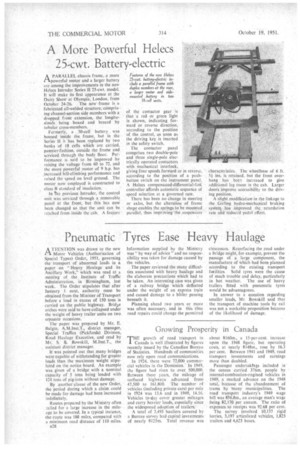Pneumatic Tyres Ease Heavy Haulage
Page 62

If you've noticed an error in this article please click here to report it so we can fix it.
ATTENTION was drawn to the new Motor Vehicles (Authorisation of Special Types) Order, 1951, governing the transport of abnormal loads in a paper on "Heavy Haulage and its Ancillary Work," which was read at a meeting of the Institute of Traffic Administration, in Birmingham, last week. The Order stipulates that after January I next, authority must be obtained from the Minister of Transport before a load in excess of 150 tons is carried on the public highway. Bride arches were said to have collapsed under the weight of heavy trailer units on two sepasate occasions.
The paper was prepared by Mr. E. Bulgin, A.M.Inst.T., district manager, Special Traffics (Pickfords) Division, Road Haulage Executive, and read by Mr. S. B. Bowskill, M.Inst.T., the assistant district manager.
It was pointed out that many bridges were capable of withstanding far greater loads than the maximum weight stipulated on the notice board. An example was given of a bridge with a nominal capacity of 5 tons being loaded with 124 tons of pig-iron without damage.
By another clause of the new Order, the period during which a claim could be made for damage had been increased indefinitely.
Routes prepared by the Ministry often ;ailed for a large increase in the mileage to be covered. In a typical instance, the-route was 188 miles, compared with a minimum road distance of 110 miles.
n28 Information supplied by the Ministry was " by way of advice" and no responsibility was taken for damage caused by the vehicles.
The paper reviewed the many difficulties associated with heavy haulage and the elaborate precautions which had to be taken. An interesting case was given of a railway bridge which deflected under the weight of an express train and caused damage to a bbiler passing beneath it.
Planning ahead two years or more was often necessary, and in this Mlle road repairs could change the permitted clearances. Resurfacing the road under a bridge might, for example, prevent the passage of a large component, the manufacture of which had been planned according to the existing transport facilities Solid tyres were the cause of much trouble and delay, particularly in hot weather. The use of heavy trailers fitted with pneumatic tyres would be advantageous.
In answer to a question regarding smaller loads, Mr. Bowskill said that the transport of machine tools by rail was not a workable proposition because of the likelihood of damage.




































































































